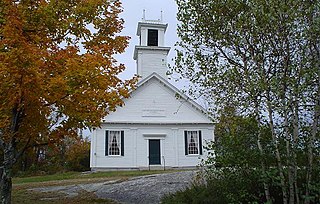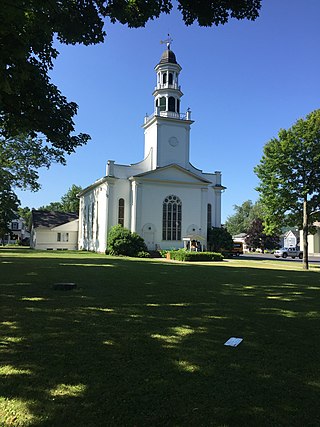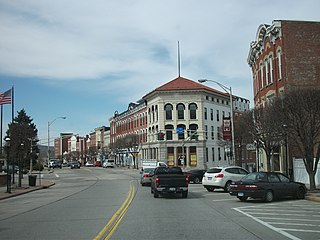
Weedsport is a village in Cayuga County, New York, United States. The population was 1,815 at the 2010 census. The name is from Elihu and Edward Weed, merchants who helped found the village. Weedsport is in the town of Brutus, west of Syracuse. It was a port on the Erie Canal. Whitford's Airport is north of the village in the town of Cato.

Ditmas Park is a historic district in the neighborhood of Flatbush in Brooklyn, New York City. The traditional boundaries of Ditmas Park, including Ditmas Park West, are Ocean Avenue and greater Flatbush to the east, Dorchester Road and the Prospect Park South neighborhood to the north, Coney Island Avenue and the Kensington neighborhood to the west, and Newkirk Avenue to the south. The name Ditmas Park is often used as a shorthand for the several neighborhoods that comprise the larger area of Victorian Flatbush.

The Mill Street–North Clover Street Historic District is located along those streets and Main Street in western Poughkeepsie, New York, United States. It is an irregularly-shaped area of 27 acres (11 ha) between US 9 and downtown Poughkeepsie, located on the slope up from the Hudson River. There are roughly 139 historic buildings, and very few new ones.

There are 75 properties listed on the National Register of Historic Places in Albany, New York, United States. Six are additionally designated as National Historic Landmarks (NHLs), the most of any city in the state after New York City. Another 14 are historic districts, for which 20 of the listings are also contributing properties. Two properties, both buildings, that had been listed in the past but have since been demolished have been delisted; one building that is also no longer extant remains listed.

The Orleans County Courthouse Historic District is one of two located in downtown Albion, New York, United States. Centered on Courthouse Square, it includes many significant buildings in the village, such as its post office and churches from seven different denominations, one of which is the tallest structure in the county. Many buildings are the work of local architect William V.N. Barlow, with contributions from Solon Spencer Beman and Andrew Jackson Warner. They run the range of architectural styles from the era in which the district developed, from Federal to Colonial Revival.

Phelps Baptist Church is a historic Baptist church located at Phelps in Ontario County, New York, USA. The church was constructed in 1845 and is an example of Greek Revival style, cobblestone ecclesiastical architecture. It is a rectangular, gable roofed building built primarily of lake washed cobbles. It is among the approximately 101 cobblestone buildings in Ontario County and 26 in the village and town of Phelps.

First Baptist Church of Painted Post is a historic Baptist church located at Painted Post in Steuben County, New York. The church was originally built in 1860 and expanded and remodeled in 1915 by architects Pierce & Bickford after a fire destroyed the mid-19th century building's tower and spire. The three-part church consists of the main block—a 40-foot-wide (12 m), 60-foot-deep (18 m), gable-roofed edifice built in 1860 and now containing the sanctuary; the front wing—a 40-foot-wide (12 m), 12-foot-deep (3.7 m) addition built in 1915 and now containing the foyer and narthex; and a noncontributing rear addition. The front wing features two massive square corner towers surmounted by louvered bell towers and bell curved roofs.

The Free Will Baptist Church is a historic church on Ridge Road in New Durham, New Hampshire. Built in 1819, it is considered the mother church of the Free Will Baptist movement, although it was not built until ten years after the death of founder Benjamin Randall. New Durham is where Randall rose to prominence, and where the church's teachings and governance were organized in 1780. The building was listed on the National Register of Historic Places in 1980.

The Metropolitan Baptist Church, located at 151 West 128th Street on the corner of Adam Clayton Powell Jr. Boulevard in the Harlem neighborhood of Manhattan, New York City, was originally built in two sections for the New York Presbyterian Church, which moved to the new building from 167 West 111th Street. The chapel and lecture room were built in 1884-85 and were designed by John Rochester Thomas, while the main sanctuary was constructed in 1889-90 and was designed by Richard R. Davis, perhaps following Thomas's unused design. A planned corner tower was never built.

Orrin W. Burritt House is a historic home located at Weedsport in Cayuga County, New York. It is a fashionable Italianate / Queen Anne style dwelling built about 1876. It consists of a large, essentially rectangular, two story frame main block. Notable features of the building include broadly projecting eaves supported by elaborate scroll brackets, dentils and modillions; large windows surrounded by elaborate wood trim; an imposing verandah with a wealth of Victorian-inspired ornamentation; and a Colonial Revival style porte-cochere added about 1912. Also on the property is a carriage house built about 1876.

Sennett Federated Church and Parsonage is a historic church formed in 1929 from the combining of Baptist and Congregational churches located in the hamlet of Sennett, in the town of Sennett in Cayuga County, New York. Both congregations were committed to the abolition movement and to the Underground Railroad. The church was constructed in 1848 for the Congregational church and probably incorporates part of an earlier 1820 church building. The parsonage was built in 1818 and was constructed as a 16 feet by 24 feet frame building. It was enlarged in the mid 19th century into a typical Greek Revival style gable and wing building, perhaps incorporating the earlier structure as the west wing.

Church Street–Congress Street Historic District is a national historic district located in the village of Moravia in Cayuga County, New York. The district contains 122 contributing buildings and one contributing structure. It is primarily a residential district and preserves several intact examples from the village's earliest period of development, 1810–1830. Numerous residential structures date to the 1830–1840 period and are in the Greek Revival style. This includes the Federal style Congregational Church (1823). Other churches located in the district are the Romanesque style Baptist Church (1874) and the Gothic Revival St. Matthew's Episcopal Church (1897–1898). The district also includes the Powers Library (1880) building and Moravia High School (1924).

Second Baptist Society of Ulysses, now known as Trumansburg Conservatory for the Arts, is a historic Baptist church located at Trumansburg in Tompkins County, New York. The building has a rectangular footprint comprising a front gable main block, built between 1849 and 1851, with a later frame addition with a hipped roof completed about 1902. It measures 54.5 feet wide by 85 feet deep, with an additional 10 feet for the porch, or verandah. The porch is supported by four fluted Doric order columns in the Greek Revival style. The church was sold to the Trumansburg Conservatory for the Arts in 1982.
Duanesburg-Florida Baptist Church is a historic Baptist church on NY 30 in Duanesburg, Schenectady County, New York. It was built between 1868 and 1869 and is a three-by-four-bay frame building with a gable roof in a vernacular Greek Revival style. It features an engaged central square tower with a pyramidal roof erected as part of the front facade in 1891. Also on the property is a contributing church hall dated to about 1913.

The Downtown Ossining Historic District is located at the central crossroads of Ossining, New York, United States, and the village's traditional business district known as the Crescent. Among its many late 19th- and early 20th-century commercial buildings are many of the village's major landmarks—three bank buildings, four churches, its village hall, former post office and high school. It was recognized as a historic district in 1989 and listed on the National Register of Historic Places, as one of the few downtowns in Westchester County with its social and historical development intact.

Linden–South Historic District is a national historic district located in the South Wedge neighborhood of Rochester in Monroe County, New York. The district consists of 136 contributing buildings, including 82 residential buildings, 53 outbuildings, and one church. The houses were constructed between 1872 and 1913 in a variety of vernacular interpretations of popular architectural styles including Gothic Revival, Italianate, Queen Anne, and Colonial Revival styles. The houses are 2 1/2-stories, are of frame or brick construction, and were designed by local architects employed by the developer Ellwanger & Barry. Among the more prominent are Andrew Jackson Warner and Claude Bragdon. The church is the former South Avenue Baptist Church, now Holy Spirit Greek Orthodox Church, built in 1909–1910 in a Late Gothic Revival style. Also in the district is a three-story, Queen Anne style mixed use building, with commercial space on the first floor and residential units above, located at 785 South Avenue.

First Baptist Church of Mumford is a historic Baptist church located at Mumford in Monroe County, New York. It was built in 1852, and is a three-by-four-bay, vernacular Greek Revival–style frame church building on a cobblestone foundation. It features a square, three stage tower. Minor expansions and alterations were done to the building through 1917.
This is a timeline and chronology of the history of Brooklyn, New York. Brooklyn is the most populous of New York City's boroughs, and was settled in 1646.

The Church of St. John the Baptist was a historic church building in Virginia, Minnesota, United States. It was built in 1924 by a Polish American congregation of Roman Catholics. In 1980 the church was listed on the National Register of Historic Places under the name Church of St. John the Baptist (Catholic) for its local significance in the themes of religion and social history. It was nominated for serving as the center of religious and social life for Virginia's Polish Americans.

First Baptist Church is a historic Baptist church complex located at Brockport in Monroe County, New York. It was built between 1924 and 1929, and consists of a Collegiate Gothic–style church building with an attached Tudor Revival Social and Recreational wing. It measures 100 feet (30 m) wide and 140 feet (43 m) deep. The church is constructed of red brick with Norristone and Medina sandstone trim. It has a slate-covered gable roof and features engaged square towers flanking the main entrance. The Social and Recreational wing has a red brick first floor and half-timbered and stucco second story. It has Norristone trim and a hipped slate roof.






















